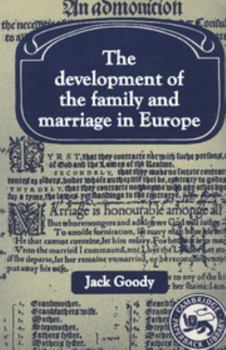Development of the Family and Marriage in Europe
Select Format
Select Condition 
Book Overview
Around 300 A.D. European patterns of marriage and kinship were turned on their head. What had previously been the norm - marriage to close kin - became the new taboo. The same applied to adoption, the obligation of a man to marry his brother's widow and a number of other central practices. With these changes Christian Europe broke radically from its own past and established practices which diverged markedly from those of the Middle East, North Africa and Asia. In this highly original and far-reaching work Jack Goody argues that from the fourth century there developed in the northern Mediterranean a distinctive but not undifferentiated kinship system, whose growth can be attributed to the role of the Church in acquiring property formerly held by domestic groups. He suggests that the early Church, faced with the need to provide for people who had left their kin to devote themselves to the life of the Church, regulated the rules of marriage so that wealth could be channelled away from the family and into the Church. Thus the Church became an 'interitor', acquiring vast tracts of property through the alienation of familial rights. At the same time, the structure of domestic life was changed dramatically, the Church placing more emphasis on individual wishes, on conjugality, and on spiritual rather than natural kinship. Tracing the consequences of this change through to the present day, Jack Goody challenges some fundamental assumptions about the making of western society, and provides an alternative focus for future study of the European family, kinship structures and marriage patterns. The questions he raises will provoke much interest and discussion amongst anthropologists, sociologists and historians.
Format:Paperback
Language:English
ISBN:0521289254
ISBN13:9780521289252
Release Date:July 1983
Publisher:Cambridge University Press
Length:324 Pages
Weight:0.83 lbs.
Dimensions:0.8" x 5.3" x 8.4"
Customer Reviews
1 rating
A real eye-opener!
Published by Thriftbooks.com User , 23 years ago
Why did Europe in particular develop the prohibitions against marry close kin that are still with us today? Why are a deceased spouse's siblings, the spouses of deceased siblings, various degrees of cousins, and god-children forbidden from being considered eligible marriage partners? The ancient Israelites, Greeks, and Romans had no such prohibitions. The Germanic peoples who settled northern Europe after the Roman Empire fell in the West did not carry these taboos with them. Where did they come from?This book argues that Fourth Century Christianity invented these marriage prohibitions which had previously not existed in either Biblical or Roman civil law traditions. The effect, if not the actual purpose, of these prohibitions was to limit the number of inheritance strategies available to property owners. By narrowing the options for trans-generational wealth transfers (including the virtual disappearance of civil adoption), the developing Church became the beneficiary of an increasingly large number of heirless people.The wealth of the Church expanded to such a point that the lay authorities had to legislate against various accumulation strategies used by the Church - culminating ultimately with the Dissolution of the Monasteries by Henry VIII.The premise is a fascinating one and does a reasonable job of explaining why we have the marriage prohibitions which are with us today. The first few chapters are a bit of a tough read as they set the anthropological ground work of the study. However, the subsequent chapters are a historians delight. Truly an innovative work.






